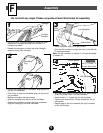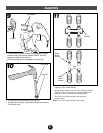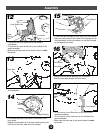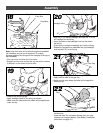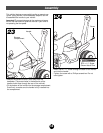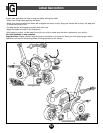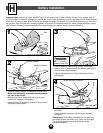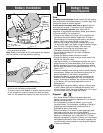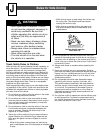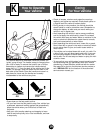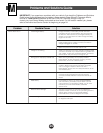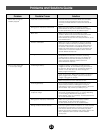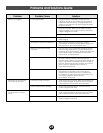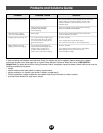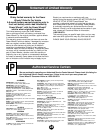
17
Battery Installation
• Rotate the lock fastener
1
/
4
turn using a slotted screw-
driver to lock the battery compartment.
• To make sure the lock fastener is locked, insert the blade
of the screwdriver under the back of the seat and push
down on the screwdriver handle. The seat should not lift.
6
• Insert the tabs on the seat into the slots in the vehicle
body and lower to close.
Note: Make sure the tabs on the lock fastener are aligned
with the notches in the lock fastener opening.
Lock
Fastener
Lock
Fastener
Opening
5
Battery Care
and Disposal
I
If a battery leak develops, avoid contact with the leaking
acid and place the damaged battery in a plastic bag. See
information below for proper disposal.
If acid comes in contact with skin or eyes, flush with
cool water for at least 15 minutes and call a physician.
If acid is internally ingested, give water, milk of
magnesia or egg whites immediately. Never give emetics
or induce vomiting. Call a physician.
• Charge a new battery for at least 18 hours before first
use. Never charge the battery longer than 30 hours.
Overcharging or undercharging the battery may shorten
battery life and decrease vehicle running time.
• After the first charge, recharge the battery for at least
14 hours after each use. Never charge the battery longer
than 30 hours. Charge the battery after each use,
regardless of how long the vehicle was used.
• The battery must be upright while charging.
• Do not allow the battery to run down completely
before charging.
• Charge the battery before storing the vehicle.
• Charge the battery at least once per month, even if the
vehicle has not been used.
• Leaving the battery in a discharged condition will ruin it.
• Always remove an exhausted battery from the vehicle.
Battery leakage and corrosion can damage the vehicle.
• Do not store the battery in temperatures above 75° F or
below -10° F.
• Prevent the battery from moving freely inside the battery
compartment. Always use the pretend engine cover to
secure the battery in the battery compartment.
• Examine the battery, charger and their connectors for
excessive wear or damage each time you charge the
battery. If damage is detected, do not use the charger
or the battery until you have replaced the worn or
damaged part.
• Attempting to charge the battery without a 25 amp fuse
or with a blown fuse will not damage the battery, but it
will not charge. Check the fuse to make sure it is in good
condition each time you charge the battery.
• Your Power Wheels
®
battery is a sealed lead-acid
battery. It must be recycled or disposed of in an environ-
mentally sound manner.
• Do not dispose of a lead-acid battery in your regular,
household trash. The incineration, landfilling or mixing of
sealed lead-acid batteries with household trash is
prohibited by law in most areas.
• Return the battery to a federal or state approved lead-
acid battery recycler, such as a Power Wheels
®
authorized service center, or a local seller of automotive
batteries. In Minnesota, call 1-800-348-0751 if further
disposal information is required. Contact your local waste
management officials for other information regarding the
environmentally sound collection, recycling and disposal
of lead-acid batteries.
Care
Disposal



